 If you ask members of my generation to specify the moment when everything in this country started to turn to shit, the majority, I’ll wager, would name one specific day and hour, and recall where and how they heard the news.
If you ask members of my generation to specify the moment when everything in this country started to turn to shit, the majority, I’ll wager, would name one specific day and hour, and recall where and how they heard the news.
Too young to vote for John F. Kennedy in 1960, I didn’t consider myself a Kennedyite, though I’d have cast my ballot for him just to keep the malignant Richard Nixon out of the White House. I stood well to the left of Kennedy on most matters, from the Cold War to civil rights, and the terror of the Cuban missile crisis remained fresh in my mind. But his relative youth suggested that perhaps his thinking had flexibility. He supported the arts, he was literate and articulate, and I certainly wished him no harm.
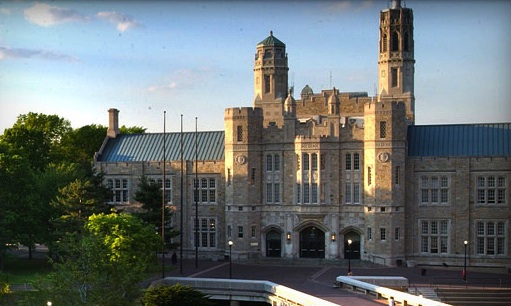
Lehman College Commons
Yes, I remember where I was on November 22, 1963 when I learned of JFK’s assassination: on the Bronx campus of Hunter College (now Lehman College), in the office of the Hunter Arrow, at work with some staffers on the bi-campus newspaper for which I then served as editor-in-chief. We had a ground-floor space in the student union, and heard a commotion on the steps and quad outside. They were announcing Kennedy’s murder over the school PA system. My colleagues held me back as I screamed in fury at the head of the campus branch of Young Americans for Freedom, cornerstone of the nascent conservative resurgence in the States. (At our 25th reunion this YAF stooge would ask me, “Are you still a Trotskyite?”)
Enter Tink Thompson
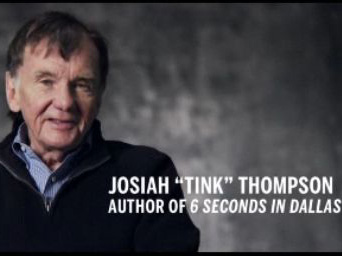
Josiah Thompson, “November 22, 1963” (2013), screenshot.
On November 21 of this year I happened across November 22, 1963, a short film by Errol Morris, himself a thoughtful occasional writer on still photography, his film published by the New York Times as part of its commemoration of the 50th anniversary of JFK’s death. This led me to an earlier short by Morris, The Umbrella Man, which, like the new one, features an unlikely interviewee: a Navy Seal turned Kierkegaard scholar turned high-profile private investigator named Josiah “Tink” Thompson. Though I met him only once, almost 46 years ago, I recognized him immediately.
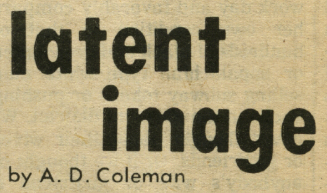
“Latent Image” column logo, Village Voice, ca. 1968.
Four and a half years after Kennedy’s death, following a stint on the West Coast, I was back in New York, starting to work as a professional freelance writer. In June of 1968 I’d publish the first of some 200 columns in the Village Voice as their designated photography critic, but almost five months before I hung out that shingle I published a feature in the Voice that concerned photography ― and the Kennedy assassination. At the time I wrote it, I’d begun to consider proposing myself as a photo critic to my Voice editor, but hadn’t yet done so. Writing this article served as one of my stepping-stones in that direction.
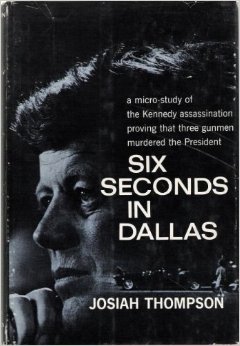
Josiah Thompson, Six Seconds in Dallas (1967), cover.
Thompson published two books in 1967: a Kierkegaard study and Six Seconds in Dallas: A Micro-Study of the Kennedy Assassination. Some consider the latter the best book about that event, though, like every book on this subject, it has its vehement detractors. In any case, it was the only investigation at that time to not just concentrate on the available film and still-photography evidence but to look, even more narrowly, at those made during the six seconds between the first shot and the last.
In short, a project involving careful attention to a set of lens-derived images. Finding it fascinating, I contacted the publisher, who arranged an interview with Thompson when he came to New York to promote the book. Here’s what I wrote in the Village Voice on February 1, 1968.
•
Six Seconds in Dallas: This Void of Silence
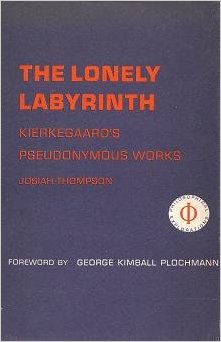
Josiah Thompson, The Lonely Labyrinth (1967), cover.
I sat in the lobby of New York’s Drake Hotel, waiting for philosophy professor Josiah Thompson, author of two just-published scholarly treatises, The Lonely Labyrinth: Kierkegaard’s Pseudonymous Works, and Six Seconds in Dallas, a scientific investigation of the Kennedy assassination. Suddenly, an elfin-faced young man was vigorously pumping my hand. “Hi,” he said earnestly. “I’m Tink Thompson.”
Heading for the bar, we made small talk until, recovering from the shock and giving him a slow once-over, I asked, “Say, how old are you anyhow?” He winced, the grimace of those who will all their lives be asked to show their identification. “Thirty-two. I know,” he added, “I look 16.” Which he does. “I would’ve guessed you were in your middle 20s,” I lied. Tink — there is no affectation in his nickname, he wears it unselfconsciously — appears a most unlikely metaphysician.
In New York for several weeks to publicize Six Seconds in Dallas, he had been making the rounds of radio and television talk shows. The experience had not left him gruntled. “It’s like charades,” he complained. “On one show I came out after Paul Anka. You know . . . ‘And here he, is ladies and gentlemen, Tink Thompson with his Kennedy assassination act!'” He shrugged, grinning.
The mirror tabletop, reflecting light upward onto his face, carved deep shadows, an effect reminiscent of kids holding flashlights beneath their chins to create fearsome masks. It turned Tink impishly satanic, a figure stepped from a Tiepolo etching. “I’m outgrowing Camus and Kierkegaard,” he responded to a question about his other book. “They’re for the young. I want to do some work on Nietzsche.”
•
Heading towards Dallas by plane, I realized that I very much wanted Texas to be different. Partly because I had simply assumed that it would be (accepting the eastern prejudice against the Southwest, and especially against Texas, where our dream died and our nightmare was born). Partly, too, because the diagnostician in me yearned to point a clinical finger at the cancer: there it is, the source of disease; slice it out, leave no trace, all will be well.
But Texas is no different. No different at all.
In Dallas, a week before I sat talking with Tink, I watched a TV program on the local drug scene. The report was titled “Is Dallas Turned On?” and the answer was affirmative. Acid, grass, amphetamines, and glue-sniffing are widespread, the last alarmingly so among sub-teens. Someday, should we survive, someone may do a sociological study on the link between Kennedy’s murder and the sudden surfacing and growth of drug use among the young.
In retrospect, it seems obvious. The college-educated segment of the Now Generation grew up worshipping two versions of the romantic hero: the idealistic man of action (Camus) and the poet-mystic (Kierkegaard). For many young people, Kennedy’s death marked the end of the first romantic dream. (By this I do not mean to imply that the dream was shattered; on the contrary, that it was fulfilled. Both romantic dreams, after all, demand the premature, sacrificial death of the hero as the only satisfying climax.)
Once the endgame of the first dream had been played out, the only remaining alternative for symbolic action was the role of poet-mystic, and drugs were the quickest ticket into the Magic Theatre. Consequently, the drug scene, relatively contained and paranoiacally clandestine prior to the assassination, burgeoned within a scant year.
So much so that now, four years later, even Dallas is turned on. Aside from drugs, the city also has rock clubs, light shows, mini-skirts, an underground paper, hippies, incense, long hair, and bells. After the tv show ended, during the station break, a disembodied male voice announced solemnly, “It’s 10 p.m. Do you know where your children are?” The temptation was to laugh and think that could only happen in Texas. But, back in New York, public service posters on the subway were playing a game called Guilt, Guilt, Who’s Got the Guilt? “Don’t help a good boy go bad,” they warned us. “Take your car keys with you.” A finer line-drawer than my shaky-handed self is needed to distinguish between those two.
•
Tink and his wife, Nancy (to whom he dedicates Six Seconds in Dallas), drove down to Washington for Kennedy’s funeral. Describing the experience, a stinging note of deep and painful sorrow echoed in his voice, and, behind that, an unstated pang of personal loss. Did Kennedy represent anything to him, and did he find Kennedy’s death symbolic?
Thompson’s tone altered, a hard sophistication (imitation Bogart unsentimentality) attempting to cover what he felt: “Yes; it was the death of taste, style, perception, wit, ideals — all that mass-media stuff . . . is that what you mean?” The challenge in Tink’s words was unmistakable; he was daring me to charge him with emotional involvement in the event. Touched, I let the gauntlet lie.
Six Seconds in Dallas achieved book form by accident. Struck by discrepancies in the Warren Commission Report, Tink began investigating on his own, and put his findings into publishable form only after meeting the editor-in-chief of Bernard Geis Associates, who pressured him to do so. He felt no disparity between his work as a philosophy lecturer and as a detective. “It was part of me, natural,” he said of the book. “You know Noam Chomsky’s essay on the responsibility of the intellectual? Well, there you are. The duty of the intellectual is always to tell the truth, especially in times of crisis.” He did not question this as a modus operandi; while he talked, there was no differentiation between the idealistic and the pragmatic, though he is quick to separate pragmatism from opportunism.
(it is hard to describe Tink, and I sit here wondering if I am conveying any inkling of the man. He looks absurdly young, talks brilliantly, has a quiet but sharp sense of humor. He is very Midwestern in his earnestness; he holds what is now considered an almost-naïve conviction, that there is knowable truth which can be determined. What is most puzzling about him, I suspect, is not so much the seeming naïveté but that he is aware that others may react negatively to it and doesn’t care. Not only doesn’t he care; it amuses him tremendously on a metaphysical plane. Yet there is no trace of smugness of self-satisfaction . . .)
•
(Part 1 I 2)
•
This post supported by a donation from Yoshio Kishi.
JFK, Tink Thompson, and “Six Seconds in Dallas” (1)
Too young to vote for John F. Kennedy in 1960, I didn’t consider myself a Kennedyite, though I’d have cast my ballot for him just to keep the malignant Richard Nixon out of the White House. I stood well to the left of Kennedy on most matters, from the Cold War to civil rights, and the terror of the Cuban missile crisis remained fresh in my mind. But his relative youth suggested that perhaps his thinking had flexibility. He supported the arts, he was literate and articulate, and I certainly wished him no harm.
Lehman College Commons
Yes, I remember where I was on November 22, 1963 when I learned of JFK’s assassination: on the Bronx campus of Hunter College (now Lehman College), in the office of the Hunter Arrow, at work with some staffers on the bi-campus newspaper for which I then served as editor-in-chief. We had a ground-floor space in the student union, and heard a commotion on the steps and quad outside. They were announcing Kennedy’s murder over the school PA system. My colleagues held me back as I screamed in fury at the head of the campus branch of Young Americans for Freedom, cornerstone of the nascent conservative resurgence in the States. (At our 25th reunion this YAF stooge would ask me, “Are you still a Trotskyite?”)
Enter Tink Thompson
Josiah Thompson, “November 22, 1963” (2013), screenshot.
On November 21 of this year I happened across November 22, 1963, a short film by Errol Morris, himself a thoughtful occasional writer on still photography, his film published by the New York Times as part of its commemoration of the 50th anniversary of JFK’s death. This led me to an earlier short by Morris, The Umbrella Man, which, like the new one, features an unlikely interviewee: a Navy Seal turned Kierkegaard scholar turned high-profile private investigator named Josiah “Tink” Thompson. Though I met him only once, almost 46 years ago, I recognized him immediately.
“Latent Image” column logo, Village Voice, ca. 1968.
Four and a half years after Kennedy’s death, following a stint on the West Coast, I was back in New York, starting to work as a professional freelance writer. In June of 1968 I’d publish the first of some 200 columns in the Village Voice as their designated photography critic, but almost five months before I hung out that shingle I published a feature in the Voice that concerned photography ― and the Kennedy assassination. At the time I wrote it, I’d begun to consider proposing myself as a photo critic to my Voice editor, but hadn’t yet done so. Writing this article served as one of my stepping-stones in that direction.
Josiah Thompson, Six Seconds in Dallas (1967), cover.
Thompson published two books in 1967: a Kierkegaard study and Six Seconds in Dallas: A Micro-Study of the Kennedy Assassination. Some consider the latter the best book about that event, though, like every book on this subject, it has its vehement detractors. In any case, it was the only investigation at that time to not just concentrate on the available film and still-photography evidence but to look, even more narrowly, at those made during the six seconds between the first shot and the last.
In short, a project involving careful attention to a set of lens-derived images. Finding it fascinating, I contacted the publisher, who arranged an interview with Thompson when he came to New York to promote the book. Here’s what I wrote in the Village Voice on February 1, 1968.
•
Six Seconds in Dallas: This Void of Silence
Josiah Thompson, The Lonely Labyrinth (1967), cover.
I sat in the lobby of New York’s Drake Hotel, waiting for philosophy professor Josiah Thompson, author of two just-published scholarly treatises, The Lonely Labyrinth: Kierkegaard’s Pseudonymous Works, and Six Seconds in Dallas, a scientific investigation of the Kennedy assassination. Suddenly, an elfin-faced young man was vigorously pumping my hand. “Hi,” he said earnestly. “I’m Tink Thompson.”
Heading for the bar, we made small talk until, recovering from the shock and giving him a slow once-over, I asked, “Say, how old are you anyhow?” He winced, the grimace of those who will all their lives be asked to show their identification. “Thirty-two. I know,” he added, “I look 16.” Which he does. “I would’ve guessed you were in your middle 20s,” I lied. Tink — there is no affectation in his nickname, he wears it unselfconsciously — appears a most unlikely metaphysician.
In New York for several weeks to publicize Six Seconds in Dallas, he had been making the rounds of radio and television talk shows. The experience had not left him gruntled. “It’s like charades,” he complained. “On one show I came out after Paul Anka. You know . . . ‘And here he, is ladies and gentlemen, Tink Thompson with his Kennedy assassination act!'” He shrugged, grinning.
The mirror tabletop, reflecting light upward onto his face, carved deep shadows, an effect reminiscent of kids holding flashlights beneath their chins to create fearsome masks. It turned Tink impishly satanic, a figure stepped from a Tiepolo etching. “I’m outgrowing Camus and Kierkegaard,” he responded to a question about his other book. “They’re for the young. I want to do some work on Nietzsche.”
•
Heading towards Dallas by plane, I realized that I very much wanted Texas to be different. Partly because I had simply assumed that it would be (accepting the eastern prejudice against the Southwest, and especially against Texas, where our dream died and our nightmare was born). Partly, too, because the diagnostician in me yearned to point a clinical finger at the cancer: there it is, the source of disease; slice it out, leave no trace, all will be well.
But Texas is no different. No different at all.
In Dallas, a week before I sat talking with Tink, I watched a TV program on the local drug scene. The report was titled “Is Dallas Turned On?” and the answer was affirmative. Acid, grass, amphetamines, and glue-sniffing are widespread, the last alarmingly so among sub-teens. Someday, should we survive, someone may do a sociological study on the link between Kennedy’s murder and the sudden surfacing and growth of drug use among the young.
In retrospect, it seems obvious. The college-educated segment of the Now Generation grew up worshipping two versions of the romantic hero: the idealistic man of action (Camus) and the poet-mystic (Kierkegaard). For many young people, Kennedy’s death marked the end of the first romantic dream. (By this I do not mean to imply that the dream was shattered; on the contrary, that it was fulfilled. Both romantic dreams, after all, demand the premature, sacrificial death of the hero as the only satisfying climax.)
Once the endgame of the first dream had been played out, the only remaining alternative for symbolic action was the role of poet-mystic, and drugs were the quickest ticket into the Magic Theatre. Consequently, the drug scene, relatively contained and paranoiacally clandestine prior to the assassination, burgeoned within a scant year.
So much so that now, four years later, even Dallas is turned on. Aside from drugs, the city also has rock clubs, light shows, mini-skirts, an underground paper, hippies, incense, long hair, and bells. After the tv show ended, during the station break, a disembodied male voice announced solemnly, “It’s 10 p.m. Do you know where your children are?” The temptation was to laugh and think that could only happen in Texas. But, back in New York, public service posters on the subway were playing a game called Guilt, Guilt, Who’s Got the Guilt? “Don’t help a good boy go bad,” they warned us. “Take your car keys with you.” A finer line-drawer than my shaky-handed self is needed to distinguish between those two.
•
Tink and his wife, Nancy (to whom he dedicates Six Seconds in Dallas), drove down to Washington for Kennedy’s funeral. Describing the experience, a stinging note of deep and painful sorrow echoed in his voice, and, behind that, an unstated pang of personal loss. Did Kennedy represent anything to him, and did he find Kennedy’s death symbolic?
Thompson’s tone altered, a hard sophistication (imitation Bogart unsentimentality) attempting to cover what he felt: “Yes; it was the death of taste, style, perception, wit, ideals — all that mass-media stuff . . . is that what you mean?” The challenge in Tink’s words was unmistakable; he was daring me to charge him with emotional involvement in the event. Touched, I let the gauntlet lie.
Six Seconds in Dallas achieved book form by accident. Struck by discrepancies in the Warren Commission Report, Tink began investigating on his own, and put his findings into publishable form only after meeting the editor-in-chief of Bernard Geis Associates, who pressured him to do so. He felt no disparity between his work as a philosophy lecturer and as a detective. “It was part of me, natural,” he said of the book. “You know Noam Chomsky’s essay on the responsibility of the intellectual? Well, there you are. The duty of the intellectual is always to tell the truth, especially in times of crisis.” He did not question this as a modus operandi; while he talked, there was no differentiation between the idealistic and the pragmatic, though he is quick to separate pragmatism from opportunism.
(it is hard to describe Tink, and I sit here wondering if I am conveying any inkling of the man. He looks absurdly young, talks brilliantly, has a quiet but sharp sense of humor. He is very Midwestern in his earnestness; he holds what is now considered an almost-naïve conviction, that there is knowable truth which can be determined. What is most puzzling about him, I suspect, is not so much the seeming naïveté but that he is aware that others may react negatively to it and doesn’t care. Not only doesn’t he care; it amuses him tremendously on a metaphysical plane. Yet there is no trace of smugness of self-satisfaction . . .)
•
(Part 1 I 2)
•
This post supported by a donation from Yoshio Kishi.